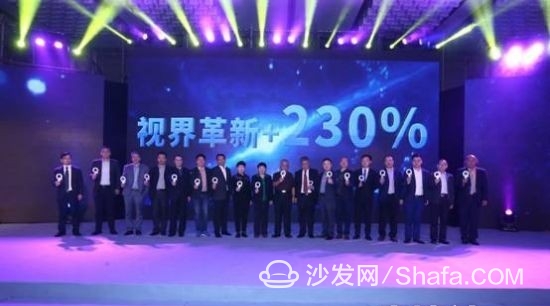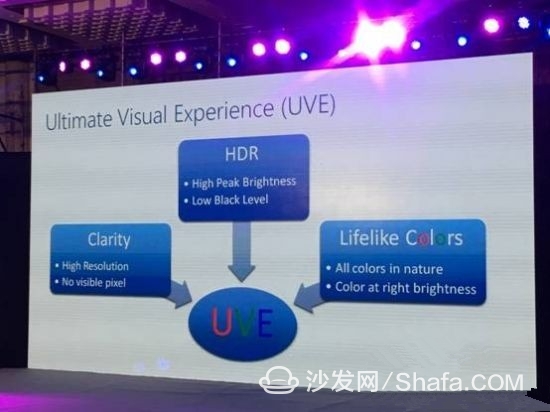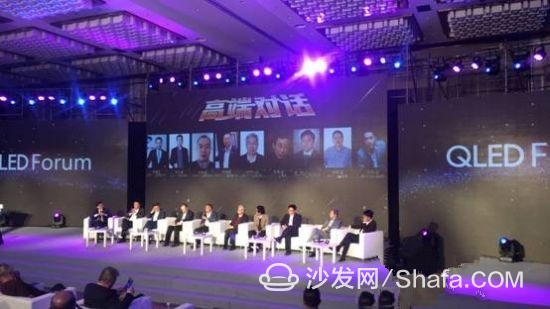The "International Quantum Dot Display Industry Forum 2017" was held in Beijing recently. Chinese and foreign quantum dot industry research institutes, experts and scholars of Quantum Dot TV upstream and downstream industrial chain companies, and corporate coffee gathered together to discuss the advantages and markets of quantum dot display technology. The development trend, together promote the popularization of quantum dot TV consumption.

From the various voices of the forum, it is not difficult to conclude that the quantum dot display technology has obvious comprehensive advantages in terms of picture quality, cost, power consumption, and longevity. Quantum dot backlight TVs on the market are more easily accepted by mass consumers. After the birth of Quantum Dot TV's ultimate form QLED TV, it will also completely end the situation of the three kinds of display technology of LCD, OLED, and laser.
Quantum Dots Bring the Ultimate Quality Experience
The ultimate quality experience that we expect from any display device is actually putting our eyes on what we can see.
Dr. Luo from Nanosys believes that this picture mainly depends on three key aspects. The first definition should not see any pixels in your observation range. The second we talk about HDR or high dynamic range, its core is that you want to be able to light up where the bright, the dark place goes dark. The third can reproduce the thousands of colors in nature, and can display its own brightness for different colors.
As the industry continues to see improvement in resolution, we are sure that there will be 8K TVs that will be produced in volume in 2017. On the second and third points, Dr. Luo and Mr. Duane Viano from SpectraCal mentioned the concept of "color rendering volume", which expands the dimensions of the NTSC color gamut, which is most commonly used in the industry and advertises a dimension. The two dimensions of the domain and brightness are put together for consideration.

Quantum dots may be the best light-emitting materials ever discovered by humans. Because they are mono-level structures, the spectrum of light after each fixed-size quantum dot is excited is extremely narrow, which is the legendary solid color. Controlling color to achieve accurate color reproduction is of great help, and because color purity is higher, richer colors can be produced, up to 110% from the two-dimensional color gamut. Samsung’s, TCL’s, and Hisense’s flagship quantum dot-TVs peaked at more than 1,500 nits this year, which means they all have a “color rendering volume†that is close to 100%.
Therefore, quantum dot backlight LCD TVs have high peak brightness, high color gamut, pure color, and long-lasting stability. They can restore all colors at any brightness level and are equipped with higher and higher resolutions. It will be able to satisfy Dr. Luo's three key points, which will bring the ultimate visual experience closer to the real world.

At the forum, a report issued by Saixi Laboratories of China Electronics Standardization Institute showed that three different brands of quantum dot backlight LCD TVs have an absolute advantage in the brightness of the peak and white field for OLEDs that claim to be the next-generation display technology. The NTSC color gamut is also dominant, with the black field brightness almost equal to the OLED TV.
Quantum dots have more commercial applications
There are many good technologies that cannot be fully commercialized and can only stand at the pinnacle of theory. A display device, the effect is excellent, if it is expensive, the life is short and it is very energy-consuming, it can not get the favor of the market. At this time, quantum dots surprised us again.
First, the quantum dot crystal is an inorganic semiconductor material, so the working state is more stable, the lifetime is longer, and the cost is lower. Second, the improvement of quantum dots is the backlight of LCD TVs. The process flow is relatively simple, and it has inherent advantages in large-scale mass production. Third, the quantum dot luminous efficiency is extremely high, which is 30% to 40% higher than the traditional LED luminous rate, and has advantages in energy saving and environmental protection.
These natural properties make the commercial use of quantum dots backlit LCD TVs more promising.
Quantum dot market has a brighter future
According to the data from China Yikang, the retail sales of quantum dot TVs in 2016 were more than seven times higher than those of OLED TVs. In the first week of 2017, QD TV's retail penetration rate reached 4.77% in the color TV market, while OLED TVs only achieved a 1.22% retail penetration rate during the same period. The famous market research agency NPD Display Search predicts that the annual growth rate of quantum dot TVs in the Chinese market will reach 100%, and it is expected to grow from 600,000 units in 2016 to 1.2 million units in 2017, and from the same time, it will reach 3 million in the global scope. Taiwan increased to 6 million units.
This pattern is mainly due to the fact that OLED TV prices are still high, and consumers are still skeptical about their life expectancy and power consumption. In principle, quantum dot backlight TVs that are improved on LCD TVs are more easily accepted by consumers.
From the perspective of the brand, Samsung, Hisense, and TCL, who are ranked No. 1, No. 3, and No. 4 in world TV shipments, are all strong QDs. Strong marketing capabilities and brand pull clearly make quantum dot technology more accessible to consumers.
The Ultimate Form of QLED Quantum Dot Display
The reason why quantum dot backlight LCD TVs are still arguing with OLED TVs is that they cannot completely improve the natural disadvantages of LCD TVs in terms of light leakage and response speed. In addition, the possibility of flexible displays is also a killer for OLEDs.
But in the previous article we have been called quantum dot backlit LCD TVs, not the ultimate form of quantum dot technology for display. Quantum dots are called "ultimate display materials" because they can be "photoluminescent" and "electroluminescent." When "electroluminescence" is achieved, it can be called quantum dot television (QLED). The backlight QLED TV is no longer needed. It will completely improve the disadvantages of the black field, flexible display, and lightness, and become a new generation of display technology with no slot.

Of course, there are still many technical difficulties in electroluminescent materials and processes that need to be overcome. The industry generally believes that the technology of QLEDs will mature 5-10 years later. However, Gao Leisheng, general manager of Najing Technology, stated that the real QLED will enter the market faster than everyone thinks, and it will only take 3-4 years.
In the introduction, quantum dot materials can even be printed on plastic sheets, and they can also be made into flexible screens. It is also more advanced than other technologies in terms of image quality, stability, energy consumption, and terminal price. The Ministry of Industry and Information Technology announced that quantum dot printing is a national key technology and is the next generation of display industry. The Ministry of Science and Technology's “Thirteenth Five-Year Plan†has also listed QLED printing as a key technology.
“The future of quantum dots is even more unimaginable,†said Peng Xiaogang, a professor at Zhejiang University and a quantum dot expert. At present, the research of photoluminescent quantum dot TV is similar to that of China. What China will do in the future is quantum dot electroluminescence. China is currently in a leading position. It is with the unremitting push of Chinese scientists that quantum dots electroluminescent display has been successfully included in the national key special projects of strategic advanced electronic materials, and has become one of the future development directions of the national strategic level.
In summary, both the quantum dot display technology and its application in the television industry are promising and promising. Good technology also needs good products, good brands, and strong market policies to promote. The “International Quantum Dots Display Industry Forum 2017†not only showcased the flagship quantum dot backlight LCD TVs of Samsung, TCL, and Hisense, but also the three companies signed super-billion-dollar orders with major channels.
According to Lu Jiebo, a well-known household electrical appliance expert and deputy secretary-general of the China Electronic Chamber of Commerce, China's color TV industry has gradually returned to the picture quality route. Quantum dot technology has become the mainstream display technology for color TV products and there is no suspense. The continuous improvement of this technology will continue to strengthen. The competitiveness of LCD technology camps. Under the high-end trend of color TVs, quantum dot technology will undoubtedly lead the new high-end television industry.
Smart TV/box information can focus on smart TV information network sofa butler (http://), China's influential TV box and smart TV website, providing information, communication, TV boxes, smart TVs, smart TV software, etc. Answering questions.

Quantum Dots Bring the Ultimate Quality Experience
The ultimate quality experience that we expect from any display device is actually putting our eyes on what we can see.
Dr. Luo from Nanosys believes that this picture mainly depends on three key aspects. The first definition should not see any pixels in your observation range. The second we talk about HDR or high dynamic range, its core is that you want to be able to light up where the bright, the dark place goes dark. The third can reproduce the thousands of colors in nature, and can display its own brightness for different colors.
As the industry continues to see improvement in resolution, we are sure that there will be 8K TVs that will be produced in volume in 2017. On the second and third points, Dr. Luo and Mr. Duane Viano from SpectraCal mentioned the concept of "color rendering volume", which expands the dimensions of the NTSC color gamut, which is most commonly used in the industry and advertises a dimension. The two dimensions of the domain and brightness are put together for consideration.

Therefore, quantum dot backlight LCD TVs have high peak brightness, high color gamut, pure color, and long-lasting stability. They can restore all colors at any brightness level and are equipped with higher and higher resolutions. It will be able to satisfy Dr. Luo's three key points, which will bring the ultimate visual experience closer to the real world.

At the forum, a report issued by Saixi Laboratories of China Electronics Standardization Institute showed that three different brands of quantum dot backlight LCD TVs have an absolute advantage in the brightness of the peak and white field for OLEDs that claim to be the next-generation display technology. The NTSC color gamut is also dominant, with the black field brightness almost equal to the OLED TV.
Quantum dots have more commercial applications
There are many good technologies that cannot be fully commercialized and can only stand at the pinnacle of theory. A display device, the effect is excellent, if it is expensive, the life is short and it is very energy-consuming, it can not get the favor of the market. At this time, quantum dots surprised us again.
First, the quantum dot crystal is an inorganic semiconductor material, so the working state is more stable, the lifetime is longer, and the cost is lower. Second, the improvement of quantum dots is the backlight of LCD TVs. The process flow is relatively simple, and it has inherent advantages in large-scale mass production. Third, the quantum dot luminous efficiency is extremely high, which is 30% to 40% higher than the traditional LED luminous rate, and has advantages in energy saving and environmental protection.
These natural properties make the commercial use of quantum dots backlit LCD TVs more promising.
Quantum dot market has a brighter future
According to the data from China Yikang, the retail sales of quantum dot TVs in 2016 were more than seven times higher than those of OLED TVs. In the first week of 2017, QD TV's retail penetration rate reached 4.77% in the color TV market, while OLED TVs only achieved a 1.22% retail penetration rate during the same period. The famous market research agency NPD Display Search predicts that the annual growth rate of quantum dot TVs in the Chinese market will reach 100%, and it is expected to grow from 600,000 units in 2016 to 1.2 million units in 2017, and from the same time, it will reach 3 million in the global scope. Taiwan increased to 6 million units.
This pattern is mainly due to the fact that OLED TV prices are still high, and consumers are still skeptical about their life expectancy and power consumption. In principle, quantum dot backlight TVs that are improved on LCD TVs are more easily accepted by consumers.
From the perspective of the brand, Samsung, Hisense, and TCL, who are ranked No. 1, No. 3, and No. 4 in world TV shipments, are all strong QDs. Strong marketing capabilities and brand pull clearly make quantum dot technology more accessible to consumers.
The Ultimate Form of QLED Quantum Dot Display
The reason why quantum dot backlight LCD TVs are still arguing with OLED TVs is that they cannot completely improve the natural disadvantages of LCD TVs in terms of light leakage and response speed. In addition, the possibility of flexible displays is also a killer for OLEDs.
But in the previous article we have been called quantum dot backlit LCD TVs, not the ultimate form of quantum dot technology for display. Quantum dots are called "ultimate display materials" because they can be "photoluminescent" and "electroluminescent." When "electroluminescence" is achieved, it can be called quantum dot television (QLED). The backlight QLED TV is no longer needed. It will completely improve the disadvantages of the black field, flexible display, and lightness, and become a new generation of display technology with no slot.

In the introduction, quantum dot materials can even be printed on plastic sheets, and they can also be made into flexible screens. It is also more advanced than other technologies in terms of image quality, stability, energy consumption, and terminal price. The Ministry of Industry and Information Technology announced that quantum dot printing is a national key technology and is the next generation of display industry. The Ministry of Science and Technology's “Thirteenth Five-Year Plan†has also listed QLED printing as a key technology.
“The future of quantum dots is even more unimaginable,†said Peng Xiaogang, a professor at Zhejiang University and a quantum dot expert. At present, the research of photoluminescent quantum dot TV is similar to that of China. What China will do in the future is quantum dot electroluminescence. China is currently in a leading position. It is with the unremitting push of Chinese scientists that quantum dots electroluminescent display has been successfully included in the national key special projects of strategic advanced electronic materials, and has become one of the future development directions of the national strategic level.
In summary, both the quantum dot display technology and its application in the television industry are promising and promising. Good technology also needs good products, good brands, and strong market policies to promote. The “International Quantum Dots Display Industry Forum 2017†not only showcased the flagship quantum dot backlight LCD TVs of Samsung, TCL, and Hisense, but also the three companies signed super-billion-dollar orders with major channels.
According to Lu Jiebo, a well-known household electrical appliance expert and deputy secretary-general of the China Electronic Chamber of Commerce, China's color TV industry has gradually returned to the picture quality route. Quantum dot technology has become the mainstream display technology for color TV products and there is no suspense. The continuous improvement of this technology will continue to strengthen. The competitiveness of LCD technology camps. Under the high-end trend of color TVs, quantum dot technology will undoubtedly lead the new high-end television industry.
Smart TV/box information can focus on smart TV information network sofa butler (http://), China's influential TV box and smart TV website, providing information, communication, TV boxes, smart TVs, smart TV software, etc. Answering questions.
On Grid Solar System,10Kw On Grid Solar System,Grid Tie Solar Energy System,7Kw On Grid Solar System
Jiangsu Stark New Energy Co.,Ltd , https://www.stark-newenergy.com